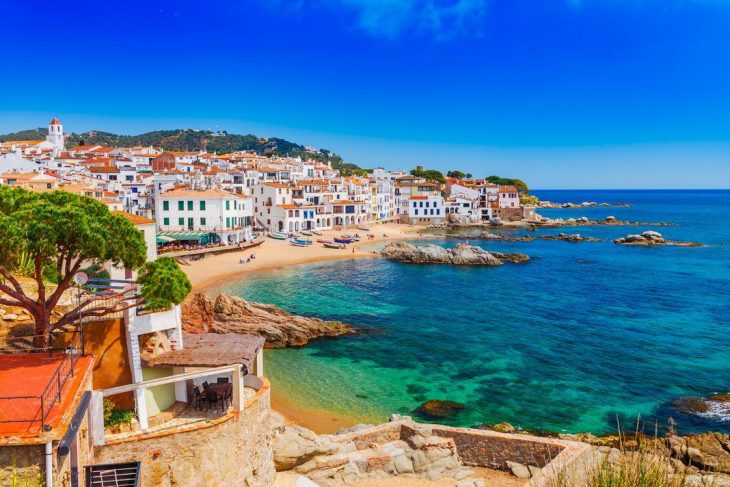
Costa Brava
About the Costa Brava
The Costa Brava is the coastal region of Catalonia in north eastern Spain, running from Blanes, 60km northeast of Barcelona, to the French border. This delightfully unspoilt stretch of coastline is home to some of Europe’s most stunning Blue Flag beaches and rugged coastlines dotted with picture postcard bays and beaches.
There’s an element of wildness to the region (hence the name Costa Brava) but the attractive towns and villages and cultural offerings add a tone of sophistication.
Unsurprisingly, the region is busiest during the summer months, popular with Barcelona residents, and visitors from France and other European countries. But with warm weather for most of the year – temperatures can hit 17° in March – the Costa Brava is certainly a year round destination.
Transport
The region is easily accessible, with international connections at nearby Girona and Barcelona airports.
The Girona province has two main train stations, in Girona and Figueres, both stops on the high speed AVE line. In addition, a rail and bus network connects many of the towns on the Costa Brava.
Top towns and villages on the Costa Brava
Historical Girona is the region’s main town, followed by the resort towns of Cadaqués, L’Escala, Blanes, Lloret de Mar and Tossa de Mar.
Girona is the region’s capital, with many interesting historic sights including an imposing Gothic cathedral, monasteries, ancient Arabic baths and a tumble of narrow, winding streets through one of Western Europe’s best-preserved Jewish Quarters.
Attractive smaller towns and villages include the hilltop town of Begur, and the coastal villages of Aiguablava, Calella de Palafrugell, Llafranc, Tamariù, Sa Riera and Sa Tuna. Here you can enjoy strolls along seafront promenades and dine at excellent seafood restaurants overlooking glorious sandy beaches.
Also noteworthy is Peretallada, a stunning walled and moated medieval village with twisting cobbled streets, stone archways and a castle built between the 11th and 14th centuries.
Platja d’Aro is one of the towns in the region that’s been designated a Family Tourism Destination. Its natural charms include small coves, coastal paths and superb beaches but there is also hiking and mountain biking, children’s play areas, family entertainment, cinemas and bowling. The town also has excellent retail opportunities, restaurants, bars and a vibrant nightlife.
To the north of the region, close to the French border, Llançà is popular with the Spanish and French thanks to the attractive beaches, excellent restaurants and stringent building regulations which ensure the continued charm of the town and surroundings.
Blanes is one of the larger towns on the coast and the Costa Brava’s first major town north of Barcelona. As a result, the town offers an excellent range of amenities, and a lively nightlife. The town’s sandy beaches are complemented by a 4km seafront promenade.
The best beaches on the Costa Brava
While the beaches are just one of many reasons for investing in property on the Costa Brava, they are undeniably special. Rather than long, sweeping beaches, the coastline is best known for its small, picturesque coves with rugged backdrops, for its powder soft sand and its deep turquoise water.
In the north of the region, highlights include Cala Portaló, near Cadaqués, where some of the landscapes and rock formations inspired artist Salvador Dalí. Also noteworthy are several beaches near Begur, in the Baix Empordà region, including Platja Fonda (accessible only via a footpath and set of steep steps), a better hideaway alternative to Tamariu and Sa Tuna.
Just beyond the busier 2km stretch of sand at Platja d’Aro, Cala Rovira is a peaceful spot, as well as being the gateway to the picturesque coves of Sa Cova, El Pi, Els Canyers and Belladona.
Outdoor lifestyle
A magnificent landscape comprising a total of eight natural parks and miles of coastal footpaths secures the Costa Brava’s place as a favourite destination for outdoor sports, such as hiking, mountain biking, swimming and skiing.
The area to the west of the coastal area comprises mountains, valleys and natural parks including the Garrotxa and Cap de Creus National Parks and the Montseny Mountain Range.
Golf
Boasting more than ten golf courses, nine open year round, golfers have their pick of some of the best in Europe. Top golf courses on the Costa Brava include one of Spain’s top courses, the PGA Catalunya Resort in Girona, Mas Nou in Platja d’Aro set 300m above sea level in the Gavarres mountain range, and the oldest course in the region, Platja de Pals Golf Course.
Hiking
Some of the best hiking opportunities are in the La Garrotxa Natural Park, where you can choose from 28 hiking trails through forests of holm oaks and beech.
For a more leisurely stroll, the Camino de Ronda is a system of old coastal footpaths with great views, traditionally used by fishermen. The footpath network runs almost the full length of the Costa Brava from Blanes to Portbou on the French border.
Winter sports
If you thought the Costa Brava was just geared up for summer, think again. In the Girona Pyrenées, you can ski in several well-established Alpine resorts such as La Molina, Masella, Núria and Vallter 2000, and the Nordic ski resort of Guils-Fontanera, where you can take advantage of the services of ski schools and mountain guides.
Water sports
The fine sandy beach and shallow sea at Sant Pere Pescador in the Aiguamolls Nature Park makes it a popular choice for all manner of water sports, including kayaking and sailing. It is also home to the World Windsurfing Championship and the World Junior Kiteboard Championship.
Llafranc has its own private marina and sailing club as well as one of the Costa Brava’s most prestigious tennis clubs.
Family and daily life on the Costa Brava
While acknowledging that the Costa Brava is enormously appealing for adults, it also offers plenty of bucket and spade fun. With Blue Flag beaches that are perfect for children and a relaxed, informal atmosphere, families will feel very welcome here.
Shops
Local shops and supermarkets are available for all your daily requirements and several towns have a weekly market. The morning food market near Palafrugell’s Plaça Nova is one of the best in the region for seafood, meat, fruit and vegetables.
Language
As part of Catalonia, Catalan is spoken amongst locals and Catalan culture and heritage is strong. Naturally everyone also understands Spanish.
Schools
The region offers a good education system, from nursery through to secondary schools, at a selection of excellent local and international schools. The choice is widest in Girona.
Attractions
Dalí is synonymous with the region. His home town is Figueres, 43km north of Girona, where the Dalí Theatre Museum, converted by Dalí from a former theatre, houses some of his most famous works. Other local Dalí connections along the coast include his eccentric summer home in Portlligat, close to Cadaqués, and his castle in the town of Púbol.
You’ll also find several interesting museums in the region, including the slightly quirky Museu de la Confitura (Museum of Jam) in Torrent, and the Museu del Suro (Cork Museum) in Palagfrugell.
Waterparks
There’s also fun for all the family at three waterparks, in Roses, Platja d’Aro and Lloret de Mar.
Gastronomy and Restaurants
With many of the world’s best known chefs beginning their careers in Catalonia, you won’t be surprised to find a strong gastronomic tradition. Enjoy great seafood such as the red-bodied gamba (prawns) de Palamos, mussels, sardines and anchovies. ‘Botifarra’ is the much-loved local raw or cured sausage and ‘fideuà’ is the local version of paella. Finish off with a delicious Crema Catalana.
The region’s calendar of gastronomic fairs and events showcases its cuisine and many of its wonderful products. One of the leading events is Palafrugell’s Garoinada, in celebration of the sea urchin season (January-March). During the autumn months, chestnut-inspired dishes appear on menus, and cake and pastry shop windows are piled high with ‘panellets’, home-made marzipan-flavoured cakes made from almond, sugar, eggs yolks and sweet potato.
When it comes to wine, some of the Costa Brava’s wineries are amongst the most highly acclaimed in Spain. The D.O. Empordà wine route is a wonderful way to discover a wine tradition that dates back to Roman times.
In terms of restaurants, you’ll find everything from rustic hideaways serving traditional food to fine dining and Michelin-starred restaurants such as the renowned Celler de Can Roca in Girona. Feast on fresh calamares and grilled sardines on the seafront and discover hideaway dining spots such as Sa Rascassa, tucked away behind the pebbled shore of Aiguafreda.
Events and Festivals
Joining in local events and festivals is a wonderful way to feel part of the local community. Leading events in the towns and villages on the Costa Brava include carnival celebrations in February, the Blanes Fireworks Contest in July, the Porta Ferrada music festival and the Girona Flower Festival. During December and the lead-up to Christmas, towns come alive with Christmas markets and living nativity scenes.
Buying property on the Costa Brava
Choose from a wide selection of property styles, from holiday apartments and townhouses to characterful country houses, contemporary family homes, and plots or villas on golf courses.
Real estate availability
The Costa Brava is a popular destination for investment, with luxury property hotspots such as Begur and the bay of Llafranc continuing to be in great demand. While houses in Llafranc can reach premium prices and are hard to come by, you’ll find a greater availability of properties in Lloret de Mar, Platja d’Aro and Calonge I Sant Antoni, with more affordable properties in Castelló d’Empúries and L’Estartit. Average house prices in the region are around €2,241/m².
